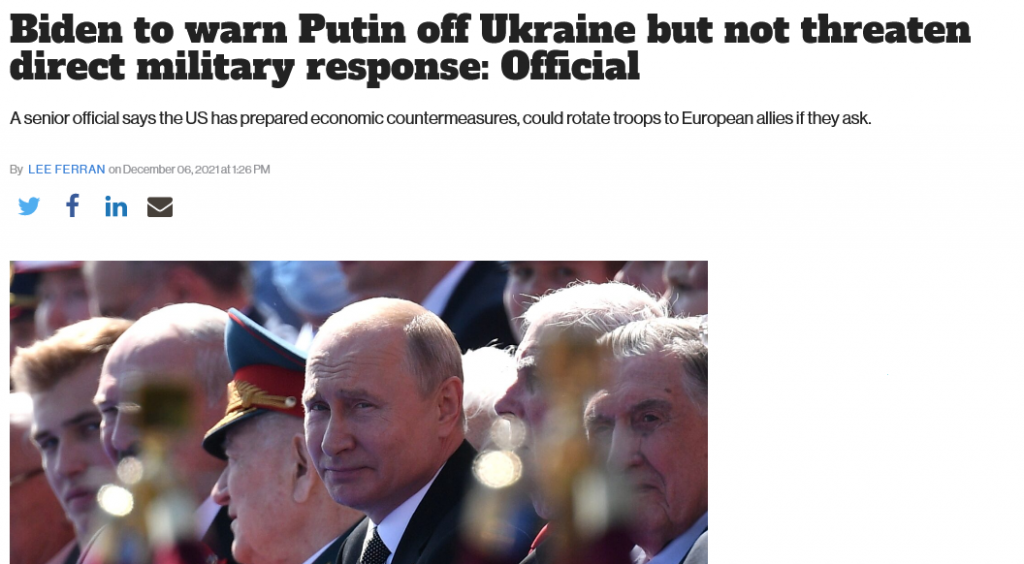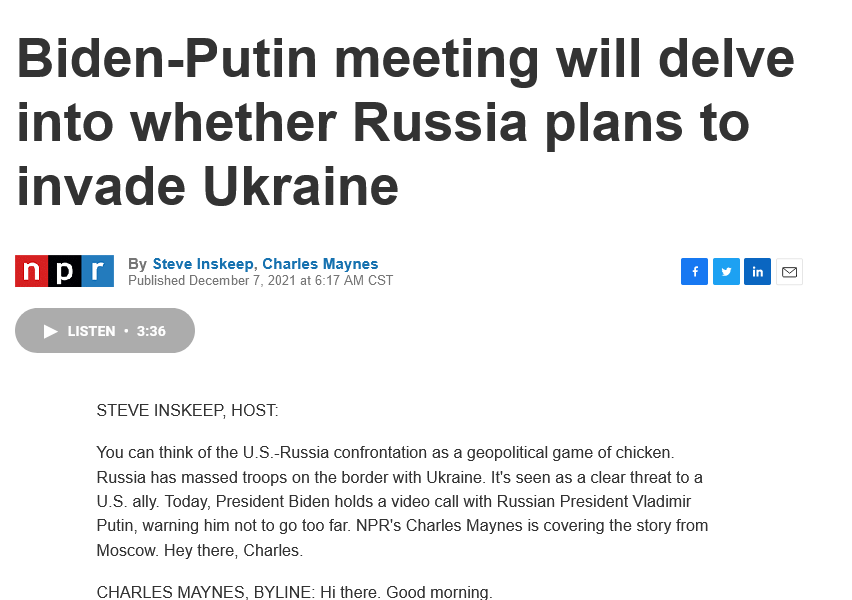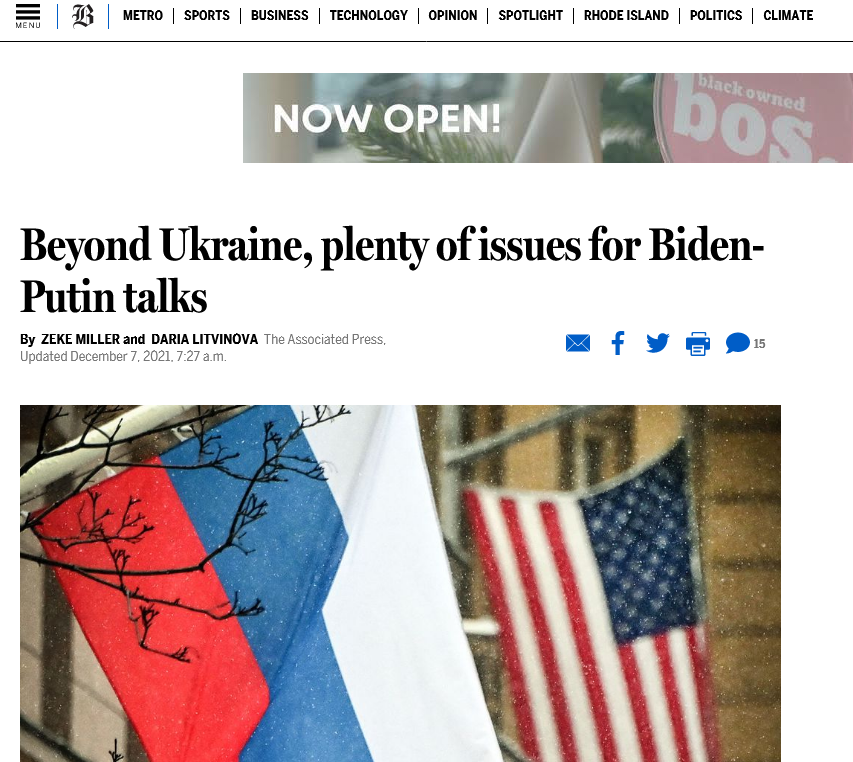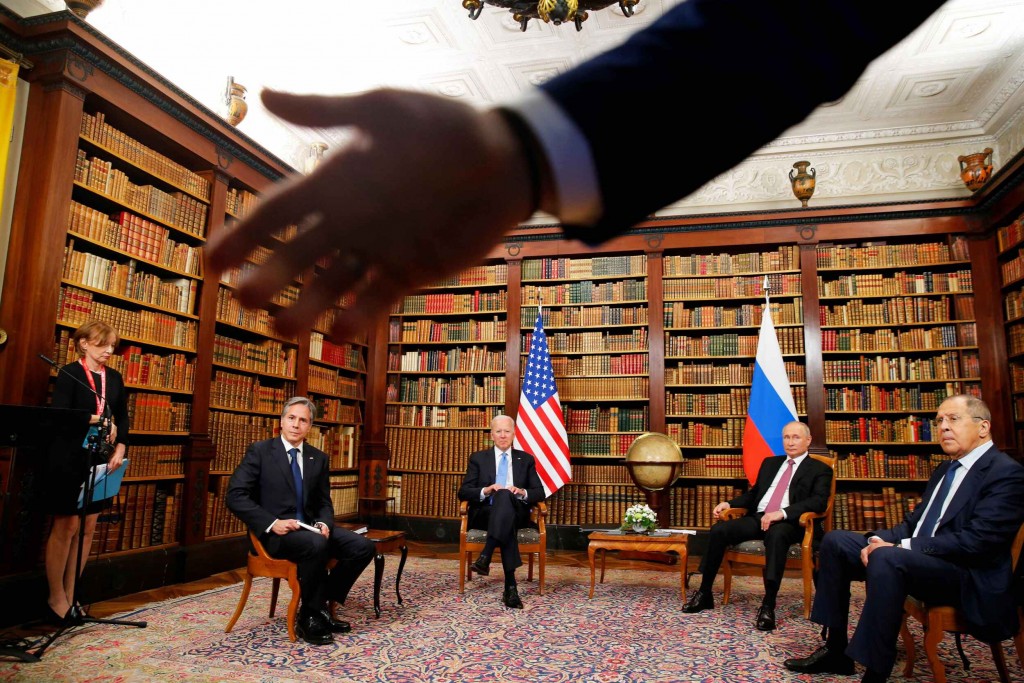- Articles
- Posted
How Western Media Dealt with the Second Putin-Biden Summit, and its Ramifications with Regards to the Syria File
Nearly six months after their first summit, which took place in Geneva in mid-June, presidents Putin and Biden held their second summit last week, this time virtually. Although the last summit was preceded by a great amount of prediction and analysis, the hype around this meeting, before and after, also was quite high, making it essential to take a closer look at what transpired in order to get a clearer picture of the stage the conflict has reached in general, and to understand what should be focused on in working in the context of the crises facing our region and Syria in particular.
Before the summit
The summit between the two presidents took place on Tuesday, December 7, and it was virtual, unlike the June meeting, which was in person. The White House released a statement a few days earlier, which noted that the “leaders will discuss a range of topics in the U.S.-Russia relationship, including strategic stability, cyber, and regional issues. President Biden will underscore U.S. concerns with Russian military activities on the border with Ukraine and reaffirm the United States’ support for the sovereignty and territorial integrity of Ukraine.”
In the days and weeks leading up to the summit, the majority of Western media focused on the issue of Ukraine, particularly saying that Russia has been mobilizing troops close to the Ukrainian borders, some even talking about “attempting to invade Ukraine”. The summit was also preceded by diplomatic activity between the two countries at a high level, including a meeting between the two countries’ foreign ministers, in which the air was unfriendly according to the media and even from their brief statements.
The rhetoric by many Western media outlets set the stage as if there is imminent danger of a war that Russia is about to launch that threatens not only Ukraine but the entirety of the world. The rhetoric sounded like beating the drums of war, some even expressing concern about Biden’s “failure” to properly handle matters and confront Russia “firmly”.
In a Politico article about three weeks before the summit, an analyst is quoted as saying: “Russia’s military moves toward Ukraine raise real questions about the administration’s current balance between confronting and engaging the Kremlin… I think it is clear that the balance needs to skew more towards confrontation.”
There was also escalation in language ahead of the meeting, including talk about the Biden administration “preparing a comprehensive set of initiatives aimed at deterring Mr. Putin from an invasion”, as British newspaper The "i" reported three days before the summit took place.
These initiatives seem to include, according to an article in The Guardian, “US punitive measure in the event of Russian military action [that] could target Russia’s new Nord Stream 2 gas pipeline, access to the Swift bank messaging system, or threaten other sectoral sanctions against the Russian economy.”
Amusingly, according to the Politico article referenced above, “when asked about the sanctions package… Biden wasn’t asking for the sanctions to be more punitive or to hurt the Russian people. Rather, the president wanted to make sure the sanctions were ‘smart’ and well-crafted so that they could change the Kremlin’s behavior.”
In the context of beating the drums of war and mobilizing public opinion about the “imminent Russian danger”, several media outlets also talked about a possible imminent military invasion and competed to exaggerate the number of the troops from under 100,000 to close to 200,000. While the Politico article talked about “thousands of troops”, the Guardian article talked about “an estimated 100,000”, The i said that “more than 94,000 Russian troops are massed near Ukraine’s borders”, while a France 24 article talked about “planning an offensive early in 2022 involving up to 175,000 troops”.

From threatening to tepidity
In the days leading up to the summit, the tone in the media and by Western officials, especially those in Washington, came across as somewhat threatening, which cooled off closer to the summit. For example, a day before, an article in Breaking Defense (a US digital magazine) made it very clear that the US actions against Russia are “unlikely to come in the form of direct US military response”, quoting a senior administration official, who also added: “I would say that the United States is not seeking to end up in a circumstance in which the focus of our countermeasures is the direct use of American military force”. Of course, other outlets continued to build up the hype and use aggressive rhetoric, which might have wanted to keep Western audiences “charged” against Russia and its moves, and as usual within the traditional American framework that always requires an “external threat” as an essential tool in managing internal affairs, especially during economic crises.
For example, an article in the Wall Street Journal started with the sentence “If the US wavers, Moscow will benefit and Iran and China will capitalize.” As is well-known, any mention of Iran and China has a severe negative effect, particularly on the American public.
Nevertheless, overall, the language leading up to the December 7th summit started softening somewhat, including talk about “mutual suspicion” and “doubt that Putin would carry through an invasion”, even quoting Fyodor Lukyanov, a prominent political analyst close to the Kremlin, as saying: “this is hysteria whipped up by the West” (a Voice of America article).
On the day of the summit but before it started, in an NPR report, its reporter in Moscow talked about how a week earlier Biden was warning of the high price Russia would pay if there were to be an invasion and reinforcing the tough message by Secretary of State Blinken. The reporter then added that “now, Biden’s team says the president prefers diplomacy”. An article in the Boston Globe, on the same day as well, noted that “Both the White House and the Kremlin have tried to lower expectations for the call, with both sides saying they don’t expect any breakthroughs on Ukraine or the other issues up for discussion. But the two powers maintain that the conversation - the leaders’ first since the summer - is progress in and of itself”, adding that there are plenty of other issues to discuss beyond Ukraine.

After the summit
On Tuesday, December 7, the two presidents spoke for nearly two hours, after which the White House released a short readout of the summit, the main part of which was that “President Biden voiced the deep concerns of the United States and our European Allies about Russia’s escalation of forces surrounding Ukraine and made clear that the U.S. and our Allies would respond with strong economic and other measures in the event of military escalation. President Biden reiterated his support for Ukraine’s sovereignty and territorial integrity and called for de-escalation and a return to diplomacy.”
It is useful to compare this with the detailed statement released by the Kremlin about the summit, which included what the White House readout stated, but provided a lot more detail about the exchanged differing opinions and views between the two sides on this issue, as well as the other issues discussed between them.
After the Western media escalation relatively calmed down, Russia Today published on December 10th, an important analytical article bearing a different tone from the entire Western media wave, starting from its title: “Putin and Biden… Mutual respect and the summit of responsibility”. The writer says in the article: “Among the most important outcomes of this summit is that Washington has begun to become convinced of the importance of the Minsk agreements and their necessity in settling the Ukrainian crisis”. Elsewhere in the article, the writer says: “This virtual summit between the Russian and American presidents was marked by high responsibility and mutual respect between them, as well as a deep understanding of the precision and sensitivity of the issues that concern their countries”.
It seems there are some who sensed a tangible retreat by Biden and his team from the earlier combative language and seeming readiness to launch a full war against Russia, a retreat which was not welcome by all. In an article in The Hill, there were hints that if Biden softens towards Moscow in case of an offensive against Ukraine, there could be resistance in Congress and preparedness to respond, and from both sides of the aisle – Republicans and Democrats alike.
Some media outlets blatantly called Biden “weak”, like the New York Post, which also downplayed his threats of using sanctions, as this would require support by allies, especially Germany, the latter mainly with regards to the Nord Stream 2 gas pipeline. This does not indicate that Biden is weak, but that he, the US, and the West in general do not possess the tool they allege possessing, not only not to confront Russia, but to continue their usual global bullying antics.
Since there were no concrete “declared” outcomes, not to mention the retreat from the beating of the drums of war ahead of the meeting, most of the media focus was on the waving of the potentially stricter sanctions, but even those were not clear and as noted above come with some caveats, like those relating to the Nord Stream 2 gas pipeline.
A New York Times article probably laid it out best, listing five takeaways from the call, which really expose how much weaker is the US’ position compared to Russia within the framework of the ongoing conflict. There takeaways were: Ukraine’s fate still hangs in the balance; Putin is standing firm; a major energy pipeline from Russia to Germany faces new risk – though the writer noted that it is unlikely that Biden would do anything in this regards to avoid a rift with Germany; Biden needs his allies; and it’s not personal, that is, there is no evidence of personal hostility between the two presidents.
A day after the summit, CNN reported that Biden “ruled out sending US troops to Ukraine to defend the country from a Russian invasion”, which is the opposite of the message that was being relayed not even a week earlier.

Escalation in rhetoric and concessions: inversely proportional!
Even without the shift in the tone of language during the days ahead of the summit that thereafter, it is clear that the US is aware that in today’s world it is no longer the world’s policeman that makes the rules, punishments, taxes, and oversees everyone’s abidance thereby. What some have realized for some time now, is becoming clearer to the rest and harder to hide or avoid seeing, particularly the West led by and subservient to the US: the era of Western hegemony is over, and the East no longer can be ignored or sidestepped.
The shift in the tone is not the only indicator, and it can be easily seen that the US is aware of this dynamic, otherwise, there would have not been neither the first summit nearly six months ago, nor this recent one. The US, more than anyone else, is aware of the inability to do anything unless there is some level of understanding in managing the conflict, and that there is a relationship to be managed, and that blowing the war horns and beating the drums of war is not how that will be done.
That is not to say that the US or the West more generally is prepared to fully and openly admit this, but actions speak for themselves. Most certainly, they do not like it, but they clearly do not have a choice in the matter. More importantly, there will be more and larger concessions by the US and the West, especially to Russia and China, but that will not happen without resistance and trying to do anything and everything to slow down or halt the shift, even if at the expense of their own peoples. In particular, the US as seen from the way it dealt with the COVID-19 pandemic and the 2008 crisis, it is the most prepared to sacrifice anything in exchange for stopping its adversaries from rising again.
Moreover, if we look at the changes that took place at the global level after the previous summit, especially with regard to Afghanistan, Yemen, and Iran, and even the nature and scope of the Russian presence in Syria, and other files, it would appear that there may be something that resembles a law about the US’ media and actual behavior within the conflict with both China and Russia: The higher the belligerent tone of Western officials and media, the more this means that the volume of concessions being offered is greater.

What does this mean in general, and for our region in particular?
As the Western hegemony is eroding and at a faster rate, we should expect to see more efforts to slow the process down or even stopping it, by trying to slow the influence of the rising powers.
Looking at the last summit and the one that was held in the summer, one of the things that the US has worked on is to stall as much as possible full implementation of most agreements reached on any of the issues. This gives the impression that the US is cooperating, while at the same time ensuring that none of the issues get fully resolved in the hopes of deepening existing crises as much as possible so that they reach a point of being unresolvable. This also helps the US in attempting to give the impression – mainly to itself, but also to Americans and the rest of the world – that it is still the side that is mainly or solely calling the shots and making the decisions at the international level.
There are several parts of the world where this is evident, including our own region. Where the US has been for years aware of its inevitable retreat from the region, and has thus focused much of its efforts on reinforcing and perpetuating the crises in different spots, playing and deepening contradictions among the region’s states, and booby trapping the region with mines it can later detonate from afar. This is what Russia, and China with it, is working on slowing down and stopping.
However, the US realizes what Russia is trying to do, so it is continuously working on creating crises in different parts of the world or in a way opening confrontation fronts between East and West all over, perchance it can drain the main players on the Eastern front and slow down their rise that is preparing to fill the gap that will be left by the Western retreat. These increasing crises also mean increasing the burdens on Russia and China, but also on the regions and countries where the crises are being deepened, to the point of breaking them and getting them to the point of no return – that is, the point where the crisis is so deep that getting out of it might no longer be possible.
This in no way means a win for the US or the West, or that the US will again be the sole superpower, as that move towards a new world balance is already underway and is irreversible, in that it also has reached the point of no return. However, the West under US leadership has reached a point of losing hope of regaining complete hegemony, and the choice for some, and definitely for the US, might be to do anything possible to stop the motion, even if this means no real gains for it except through destruction of as many countries as possible, especially those that can benefit from the rise of the Eastern camp again.
Thus, what this requires, in the context of at least our region and Syria in particular as the center, based on the fate of which the region can collapse or recover, is a greater coordination between Russia and China, on in Syria-specific lingo, between Astana and China. The main goal from increasing and intensifying the coordination should be to take complete charge of regional initiatives, in a manner that ensures working towards and reaching solutions for all the crises and as soon as possible before they reach the point of no return. These initiatives should be designed such that they can proceed forward with or without the US and regardless of the US’ role and “activities” in the region, but keeping the door ajar for Washington, in case it reaches the conviction that it is time to admit the reality of matters and to mitigate losses, including its own.




